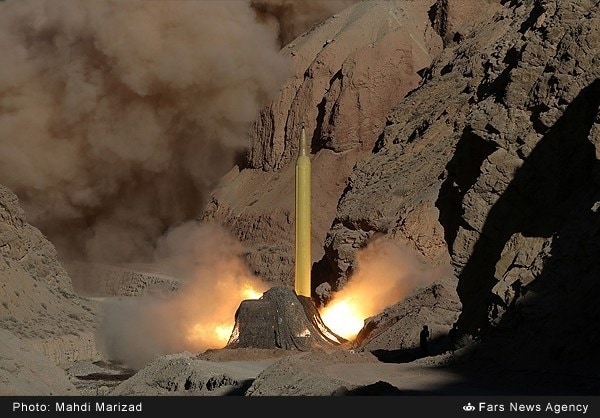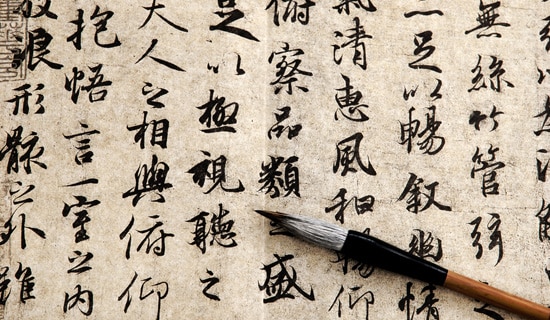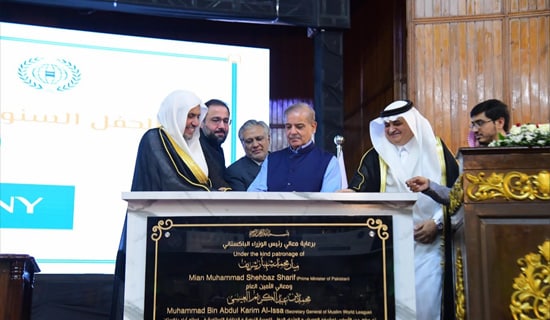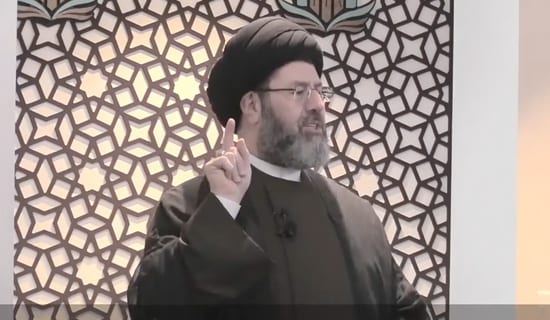On March 8-9, 2016, as part of their annual missile drill, which this year is named "Power of the Rule [of the Jurisprudent]" (Eqtedar-e Velayat), Islamic Revolutionary Guard Corps (IRGC) forces launched long-range ballistic missiles, including Qadr-F and Qadr-H missiles, with ranges of 2,000 and 1,400 kilometers, respectively; Qiam missiles, launched from underground silos with a range of 800 kilometers, as well as Shahab-1 and Shahab-2 medium-range missiles. The launch was attended by IRGC commander Ali Jafari and the head of the IRGC aerospace and missile division, Amir Ali Hajizadeh.[1] On the backdrop of the missile launch, IRGC officials also explicitly threatened Israel, stating that the missiles were meant "to destroy the Zionist enemy."
Media reports also indicate that missiles launched on March 9 were emblazoned with the slogan "Israel should be wiped off the face of the earth" written in Hebrew and Farsi (see image below).[2]

In a video, Hajizadeh presented an underground missile silo and said: "These ballistic missiles, which possess pinpoint accuracy, are deep underground. When needed, they are fueled and activated and then moved to underground silos for launch." According to him, the IRGC's underground missile launch silos are the main complimentary element to the IRGC's "missile cities."[3]
For excerpts from his statements, see the MEMRI TV clip below:
This document will review statements by IRGC commanders regarding Iran's missile capabilities and the missiles' intended targets :
IRGC Commander: "Our Missiles Cover The [Territory Of The] Occupying Zionist Regime, Therefore They Fear [Us] The Most"
IRGC Commander Ali Jafari said on March 8 that "holding this drill and launching ballistic missiles from different points in Iran are a decisive response to the boastfulness of [our] enemies regarding levelling sanctions [on Iran] due to the missiles. This missile launch displays only a portion of the capabilities of the IRGC's underground launch silos, which have been expanded throughout Iran.
"The Eqtedar-e Velayat drill will make our enemies realize that the robustness of our defense and national security are red lines, and we are totally unwilling to negotiate about them. The regime of the Islamic Republic of Iran considers security in the face of hostility to be the most important issue and a top priority... Nearly 100% of our production is domestic, and we do not rely on foreigners. We grew under sanctions and have become independent [despite them].
"Iran's officials consider the IRGC's missile capabilities to be a red line and are of one mind on this issue. Our enemies, too, have understood that increasing the sanctions and the security pressure has no impact on the growth of our capabilities. That is why they are levelling economic sanctions, in order to limit our missile capabilities.
"The Eqtedar-e Velayat drill sends a message of security to Iran and neighboring countries in the region. Iran's security is the security of the countries of the region, and all our efforts are meant to maintain our national security.
"While confronting the enemies, the IRGC's finger is always on the trigger. The enemies of the Islamic Revolution should fear the roar of the IRGC's missiles.
"The main threat against Iran comes from the Zionists. Those most hostile towards Iran should naturally fear this readiness and these capabilities the most. Our missiles cover the [entire territory of the] occupying Zionist regime, therefore they fear [us] the most."[4]
IRGC Deputy Commander: The Zionist Regime Will Collapse In The Near Future; Hizbullah Has 100,000 Missiles And Iran Has Tens Of Times That Amount
IRGC Deputy Commander Hossein Salami said at a press conference held after the March 9 missile launch: "If the enemy wishes to realize its ill intent towards Iran, it must know that our missiles are ready to launch and ready to strike it. These missiles are the product of the sanctions, and the more the sanctions increase, the more our development [of them] will increase as well.
"The Zionist regime will collapse in the near future. Hizbullah has stockpiled over 100,000 missiles, while Iran has a variety of missiles [and a stockpile] tens of times greater than Hizbullah's, and this power will not be stopped. We stockpile many ballistic missiles with varying ranges, which can hit enemy targets at any moment from different locations in Iran.
"Yesterday we launched missiles from underground silos and today we launched them from the heart of Iran. The purpose of this drill is to demonstrate our desire for defense and deterrence. Our storage capabilities are smaller than our production capabilities. We are relaying all of our experience and all of our operational, scientific, tactical and strategic achievements to our brothers in the Islamic world and in the front of resistance to America, Israel and their regional allies."[5]
IRGC Aerospace And Missile Division Commander: These Missiles Are Iranian But Belong To The Palestinian, Lebanese, Syrian, And Iraqi Peoples... Their 2,000-Kilometer Range Is Intended To Confront The Distant Zionist Regime
SUPPORT OUR WORK

IRGC Aerospace and Missile Division Commander Amir Ali Hajizadeh said after the missile launch on March 9, 2016: "These capabilities are the product of the enemy's sanctions, and the more its sanctions increase, the more our response, progress, and capabilities will increase as well. After the JCPOA, the enemies are targeting the Iranian nation's security. Sanctions [due to missile activity] compromise Iran's security, but the IRGC is protecting it...
"These missiles are totally Iranian but [also] belong to the Palestinian, Lebanese, Syrian, and Iraqi peoples, and to all of the world's oppressed peoples. We do not wish to expand the state's borders, but rather to assist the oppressed against evil. Anyone who wishes to tyrannize the oppressed Muslim nations must know that these missiles will threaten it. We do not use these missiles against terrorist groups, even though this is possible.
"Israel is currently surrounded by Islamic states and its life expectancy is short. In a war, it will collapse before these missiles are [even] launched.
"We believe in America's hostility and attribute importance to it. We will not start a war, but neither will we be caught by surprise. Therefore, we have located our tools [of war] in a place that cannot be destroyed according to the enemy's whims, and [therefore] we can wage a prolonged war.
"For us, Israel's evil is totally clear, and the 2,000-kilometer range of our missiles [is intended] to confront the distant Zionist regime. We are expanding our tunnels and silos, and will respond harshly to enemy folly."[6]
Hajizadeh: Even An Atomic Bomb Cannot Destroy Our Tunnels; Some Of Our Missiles Are Ready For Launch; We Can Instantly Launch Hundreds Of Missiles At Designated Targets
Hajizadeh told the Tasnim News Agency that, "in many cases, the IRGC has helped the government with large scale projects of tunnel construction. For 31 years, we have been working day and night to construct tunnels. We have also constructed missile storage facilities, silos and other underground facilities...
"We must be strong so that we can defend the Iranian nation. We must not allow foreign elements to easily create problems for our people. Now Iran is safe and secure. The security of the people is a red line for us, and on this matter we do not observe agreements with anyone, and the IRGC is not remiss in this.
"The people will accept poverty, but no one will agree to jeopardize our security. Therefore, the Majlis and government must help us to strengthen our defensive and missile capabilities in the coming years...
"We have extensive experience in constructing tunnels and we are certain that even if an atomic bomb hits them, they will not be destroyed. We dug these tunnels under mountains and they have high security ratings.
"A large number of our units are on call 24 hours a day and do not know the meaning of vacation. Some of our missiles are upright and ready for launch... Officers have authorization [to attack], and immediately following an attack they can respond [by] instantly launching hundreds of missiles at designated targets.
"It is a complete mistake to think that America can supervise our missile cities. Some attribute importance to America, but America is not that powerful. Perhaps some of our tunnels can be identified, but they certainly cannot be destroyed.
"For us, America is nothing, since we are highly capable and it cannot fight us. [The Americans] are so weak that in 2009, when they wished to leave Iraq, they were concerned about leaving without getting harmed. They sent an Iraqi official from the American embassy [in Iraq] and asked the IRGC for help so their troops could withdraw with dignity. When that representative returned to Iraq, the American ambassador waited for him at Baghdad Airport to see what Iran had said...
"We have acquired the ability to produce missiles with complex mechanisms... Even if they surround all of Iran with walls, our missile production will not stop. We have no need for [the help of] any country."[7]
In a dig at President Rohani, who visited France and posed for a photo in front of French planes, Hajizadeh said: "Some took souvenir pictures with the French Airbus, but we take pictures with our local Iranian products, which are our source of pride and honor."[8]

Hajizadeh
and Salami with Iranian reporters with a missile in the background
Advisor To Khamenei's Representative In The IRGC: 'America's Dreams Of Limiting Iran's Missile Strength Will Never Come True... Iran Has Missile Cities, Underground Silos, And Thousands Of Missiles'
Yadollah Javani, an advisor to Khamenei's representative in the IRGC, said on March 9, 2016: "This drill demonstrates the deterrence and multifaceted defensive capabilities of the armed forces, particularly of the IRGC, who can confront any kind of external military threat to the Islamic Revolution...
"Military experts rank Iran fourth in the world in terms of missile strength... After America, Russia and China, Iran is the fourth country to possess underground ballistic missile launch facilities...
"Launching IRGC ballistic missiles from underground silos sends a clear message to the enemies of the Iranian nation. The roar of the IRGC's ballistic missiles is a decisive response by the Iranian nation to the missile sanctions against it. If some enemies thought that the JCPOA and missile sanctions could limit Iran's defensive strength, this drill has shown that these thoughts are starkly at odds with reality... The message is clear: America's dreams of limiting [Iran's] defensive might, particularly its missile strength, will never come true, but as time goes by, Iran's missiles increase in quantity, range, accuracy and effectiveness... The Iranian nation is determined to preserve its deterrent force, and add to its reliability every day.
"Presenting the missile cities and expanding them to a depth of 500 meters underground in many points in Iran, as well as constructing missile silos and storing thousands of missiles with varying capabilities in these cities, indicate that [these cities] house thousands of professional experts who possess a jihadi spirit and Basij thinking. These forces are prepared to respond to any invader. This prominently strengthens Iran's defensive and deterrent power.
"The enemies' fear of the roar of the IRGC's missiles is evident from their efforts to level missile sanctions in order to limit Iran's defensive programs. The enemies must know that there is a fundamental difference between Iran's peaceful nuclear program and Iran's defensive missile program. The most important difference is that the nuclear program is open to discussion, while the missile program and Iran's other defensive military measures are not. No nation can agree to negotiate and agree with its enemies on its own defensive measures. The message sent by the Eqtedar-e Velayat drill stresses this matter to all enemies."[9]
APPENDIX: Images From Ballistic Missile Launch
Below are images from the launch of a long-range Qadr-H missile, with a range of 1,400 kilometers. The missile was launched from the Alborz Mountains in eastern Iran to the coast of Makran in southern Iran near the Gulf of Oman. The missile weighs 17 tons, is 16 meters long and 1.25 meters in diameter, and carries a detachable 650 kilogram warhead.[x]


Endnotes:
[1] Fars, Tasnim (Iran), March 8, 2016.
[2] Twitter.com/alialimadadi110, March 9, 2016.
[3] For more on Iran's "missile cities," see for example MEMRI TV clip No. 5107, Iran Unveils Bases with Long-Range Missiles under Iranian Cities, October 14, 2015. For a detailed report on Iran's missile program, see MEMRI Inquiry and Analysis No. 1135, Iranian IRGC Missile Unit Commanders: We've Developed 2,000-km Range Missiles And Equipped Hizbullah With 300-km Range Missiles; Fars News Agency: Israel's Illusions About Its Natural Gas Fields Will Be Buried In The Mediterranean, December 4, 2014.
[4] Fars (Iran), March 8, 2016.
[5] Fars (Iran), March 9, 2016.
[6] Fars (Iran), March 9, 2016.
[7] Tasnim (Iran), March 9, 2016.
[8] Tasnim (Iran), March 9, 2016.
[9] Javan (Iran), March 9, 2016.
[10] Fars (Iran), March 9, 2016.




